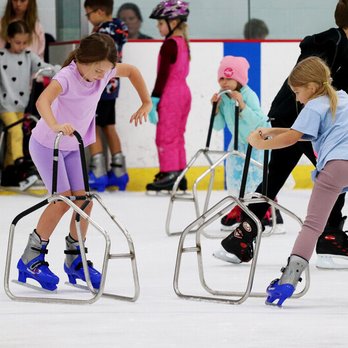Ice skating is an exciting and fun activity that kids can enjoy, whether they are just starting out or are already gaining some experience on the ice. It’s a great way to stay active, build confidence, and have fun with family and friends. However, like any sport, ice skating comes with its risks, especially for children who are still learning the ropes. Falls, collisions, and accidents can happen, so it’s essential to prioritize safety while skating. In this article, we’ll go over some important safety tips for kids learning to ice skate to ensure they have a safe and enjoyable experience on the rink.
1. Always Wear Proper Safety Gear
One of the most important ways to keep kids safe while ice skating is by ensuring they are wearing the proper protective gear. While it might not be mandatory at all rinks, it’s a smart idea to have children wear safety gear to minimize the risk of injury.
Essential Protective Gear for Kids:
- Helmet: A helmet is essential to protect your child’s head from potential falls and collisions. Even for beginners, the risk of a head injury is significant, and a helmet can prevent serious accidents. Make sure the helmet fits snugly and is designed for ice sports.
- Wrist Guards: Kids tend to use their hands to break their fall, which can lead to sprained or broken wrists. Wrist guards help protect against this common injury and should be worn by all beginners.
- Knee and Elbow Pads: These pads offer extra protection in case your child falls or trips. They can prevent bruising, scrapes, and more severe joint injuries, which are especially important for young skaters.
- Mouth Guard: If your child is participating in figure skating or hockey, a mouth guard can protect against injuries to the teeth and gums.
2. Choose the Right Skates
For kids, the right pair of skates is crucial for both safety and comfort. Ill-fitting skates can lead to discomfort, difficulty balancing, and even injury. When buying or renting ice skates for your child, be sure to look for these key features:
What to Look for in Ice Skates for Kids:
- Proper Fit: Skates should fit snugly but not be too tight. A loose skate can cause instability, while tight skates can lead to blisters and discomfort. Make sure your child’s toes are comfortably placed at the front of the boot, and there is no excess space around the heel.
- Ankle Support: Skates with good ankle support help kids maintain balance and stability on the ice, which is especially important for beginners.
- Quality and Condition: If renting skates, check that they are in good condition. Worn-out or poorly maintained skates can affect your child’s ability to skate safely. If purchasing skates, opt for good-quality boots with sturdy blades.
- Lacing: Ensure the skates are laced tightly, especially around the ankle, to provide support and prevent the foot from shifting inside the boot. Loose laces can lead to instability and falls.
3. Teach Kids How to Fall Safely
Falling is a part of learning to ice skate, so it’s essential to teach your child how to fall safely to minimize the risk of injury. Instruct your child to bend their knees slightly when skating, which will lower their center of gravity and reduce the likelihood of falling. But if they do fall, they need to know how to do it properly.
Safe Falling Tips:
- Don’t Reach for the Ice: Encourage your child not to extend their hands straight out in front of them. Reaching forward can increase the chances of injuring the wrists and elbows. Instead, teach them to fall to the side or backward if possible.
- Relax and Go with the Fall: Teach your child to stay relaxed when falling. If they are tense, they are more likely to hurt themselves. Encourage them to go with the fall, bending their body and rolling with the momentum.
- Stay Low: Lowering their body by bending their knees will help them fall with more control, reducing the impact.

4. Practice Balance and Skating Fundamentals
Before letting your child speed around the rink, it’s crucial that they learn and practice basic skating techniques. Good balance is key to preventing falls and skidding out of control. Spend some time working on these fundamentals:
Basic Skating Skills for Kids:
- Bend the Knees: Make sure your child keeps their knees slightly bent when skating. This will help them maintain a lower center of gravity and make it easier to balance.
- Gliding Instead of Stomping: Teach your child to glide their skates rather than stomp their feet, which can cause them to lose balance. Gliding is smoother and allows for more control on the ice.
- Stopping Techniques: It’s important for kids to learn how to stop safely. A simple way to teach stopping is through the “snowplow stop,” where they push the inside edges of their skates outwards to slow down and come to a halt.
- Arm Positioning: Arms should be held slightly out to the sides for balance. Encourage your child to use their arms to help maintain stability rather than flailing them around.
5. Supervise Kids on the Ice
Supervision is crucial, especially for younger children or those who are just beginning to skate. Even if your child is fairly independent, keeping a close eye on them will help ensure they are safe and prevent accidents from occurring.
Supervision Tips:
- Stay Close: When your child is learning to skate, stay close by to assist them if they fall or need help. This is especially important for beginners who may lack confidence on the ice.
- Be Ready to Help: Be prepared to offer a helping hand if they lose their balance or need assistance getting up after a fall.
- Encourage Caution: Remind kids to stay cautious, especially when skating at higher speeds or near other skaters. They should avoid running or suddenly speeding up on the ice.

6. Know the Ice Rink Rules
Every ice rink has rules to keep everyone safe, and it’s important to familiarize your child with these guidelines before they step onto the ice. Many rinks will provide safety instructions, but here are a few common rules to keep in mind:
Important Ice Rink Rules:
- Skate in the Correct Direction: Most rinks have a designated skating direction. Teach your child to skate in the correct direction to avoid collisions with other skaters.
- Avoid Rough Play: While ice skating can be fun and energetic, it’s important to avoid rough play or aggressive behavior on the rink. Encourage your child to skate calmly and avoid pushing or shoving others.
- Yield to Faster Skaters: More experienced skaters may be moving faster, so remind your child to yield to others, especially if they’re just learning.
- No Horseplay: It’s easy for kids to get excited and want to rush, but horseplay on the ice can lead to serious accidents. Teach your child to skate responsibly and to stay alert to their surroundings.
7. Take Frequent Breaks
Ice skating can be tiring, especially for beginners. Kids who are just starting to learn may tire quickly, and overexertion can lead to accidents. Make sure your child takes breaks when they need to rest.
Tips for Breaks:
- Frequent Rest Periods: Encourage your child to take a break every 20-30 minutes. This will help prevent fatigue and keep them fresh on the ice.
- Stay Hydrated: Even though ice skating can be cold, kids still need to stay hydrated. Bring water bottles or take breaks in the rink’s designated rest areas.

8. Monitor Ice Conditions
Lastly, always check the condition of the ice before starting to skate. Outdoor rinks, in particular, may have patches of rough or uneven ice, which can increase the risk of slipping and falling.
How to Check Ice Conditions:
- Cracks and Bumps: Before your child starts skating, inspect the ice for any cracks or uneven spots. Avoid skating in areas with visible damage.
- Wet Spots: Be cautious of wet or overly slick spots that may cause skaters to slip.
Conclusion
Ice skating is a thrilling and rewarding activity for kids, but safety should always be the top priority. By wearing the right gear, teaching safe skating techniques, supervising kids closely, and ensuring the ice conditions are safe, you can create a fun and safe environment for your child to learn and enjoy skating. With the right precautions, kids will gain confidence on the ice and, most importantly, stay injury-free while having a blast!

